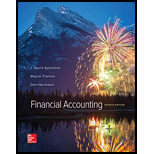
Written Communication
Required:
1. Define liabilities and stockholders’ equity.
2. Provide arguments in support of maintaining the distinction between liabilities and stockholders’ equity in the
3. Provide arguments in support of eliminating the distinction between liabilities and stockholders’ equity in the balance sheet.
4. Which do you recommend? Why?
Want to see the full answer?
Check out a sample textbook solution
Chapter 10 Solutions
Financial Accounting
- Answer the following questions: Define and discuss the term "equity" What financial statement element, other than equity, is typically affected by owner investments and distributions?arrow_forwardWhich of the following statements is/are correct? i. The sale of stocks is also referred to as equity finance ii. The sale of bonds is also referred to as debt finance a.Only i b.Only ii c.Both i and ii are incorrect d.Both i and ii are correctarrow_forwardChoose the correct answer: Equity security acquired for non-trading and the shares are not enough to warrant significant influence should be measured at the end of the period a. cost, being the purchase price b. cost, being the purchase price plus transaction costs c. fair value, with change in FV taken through profit or loss. d. fair value, with change in FV taken through other comprehensive incomearrow_forward
- Which of the following is the second option in measuring the equity instrument issued to extinguish a financial liability A.fair value of the equity instrument B.carrying amount of the equity instrument Cfair value of the financial liability D.carrying amount of the financial liabilityarrow_forwardUnder FASB 52, the temporal method requires that: A. translation gains and losses are included in the reported net income. В. translation gains and losses are only included in stockholder's equity. C. translation gains and losses should not be considered. D. none of these, QUESTION 13 A CFO should be least worried about A. transaction exposure. B. translation exposure. C. economic exposure. D. none of the options QUESTION 14 The most effective way to hedge translation exposure is: A. to buy forward contract. B. to buy call option contract. C. to use balance sheet hedge. D. to use regression method.arrow_forwardAccounting Theory discussion Required: Support or deny the elimination of the distinction between debt and equity using the entity theory and the proprietary theoryarrow_forward
- Which statement is not true? Equity investment and trading debt investment have the same accounting about how to report their unrealized gain/loss and how to report them on the balance sheet. Only debt securities, not equity securities, can be classified as held-to-maturity, available-for-sale or trading. Change in fair value of available-for-sale and held-to-maturity debt investments have no impact on net income. Cash flows relating to held-to-maturity investments and trading investments involve both investing and operating activities.arrow_forwardPro forma statements: Multiple Choice must assume that no new equity is issued. must assume that no dividends will be paid. exclude net working capital needs. are projections, not guarantees. are limited to a balance sheet and income statement.arrow_forwarddont provide AI solution otherwise i give dislike .......plesa note be carefully What is the formula for calculating the debt-to-equity ratio? a) Total Assets / Total Liabilities b) Total Liabilities / Total Equity c) Total Equity / Total Assets d) Total Revenue / Total Expensesarrow_forward
- which of the following is not an advantage of equity rather than debt financing a. lower cost b. lower risk of insolvency c. lower funding risks d. no legal liability to pay dividends e. no requirement to repay capital.arrow_forward13. Investments in equity instruments are financial assets because they are Group of answer choices Contractual rights to receive cash or another financial asset from another entity. Cash equivalents. Contractual rights to exchange financial assets or financial liabilities with another entity under conditions that are potentially favorable to the entity. Equity instruments of another entity.arrow_forwardNo explanation is required. Direct answer shall be appreciated :)arrow_forward
 Cornerstones of Financial AccountingAccountingISBN:9781337690881Author:Jay Rich, Jeff JonesPublisher:Cengage Learning
Cornerstones of Financial AccountingAccountingISBN:9781337690881Author:Jay Rich, Jeff JonesPublisher:Cengage Learning


